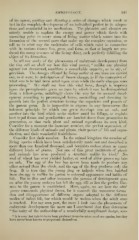Page 531 - My FlipBook
P. 531
EMBRYOLOGY. 541
of its career, guid'uuj and directing a series of changes which result at
last in the complete development of an individual perfect in its adapta-
tions and wonderful in its mechanism. The physicist and chemist are
utterly unable to explain the energy and power which throb with
unceasing pulse in every atom of living matter which enters into the
formation of the several parts that make up the complete organism, or
tell us in what way the multitudes of cells which exist in connection
with its various tissues live, grow, and form, so that at length are pro-
duced the many textures of the living thing, each perfectly fulfilling the
object of its formation.
In all our study of the })henomena of embryonic development from
the tiny cell we shall see how this vital power, '' unlike any physical
agency yet discovered, manifests a remarkable capacity, so to say, of
prevision. The changes effected by living matter at one time are carried
out, as it were, in anticipation of future change, as if the conception of
what loas to be had been acted upon even while the etu'ly changes were
proceeding." We shall see how this vital force, though it imprints
upon the ])rotoplasmic germ no trace l)y which it can be distinguished
from a fellow-germ, unfailingly clears the way for its onward devel-
opment according to prearranged forms, controlling and directing its
growth into the perfect structure having the capacities and powers of
the parent germ. It is impossible to ex])ress in any force-terms the
inherent principle by which one germ develops into an oak, and
another into the bird which seeks shelter amid its foliage, or explain
how typal forms and peculiarities are handed down from generation to
generation, so that each plant and animal reproduces its own kind.
Consider for a moment the immense number, the perfect separation, of
the different kinds of animals and plants, their power of life and repro-
duction, and their wonderful fruitfulness.
Consider first their number. In the animal kingdom the number of
living species which have been satisfactorily made out and descril^ed is
more than one hundred thousand, and botanists reckon about as many
diflFerent kinds of plants. Not one of this great multitude of plants
and animals has ever produced a structure unlike its kind.^ No
seed of wheat has ever yielded barley, or seed of alder grown up into
an oak. The egg of the hen has never been made to produce any
other animal than the chick, and the egg of the frog produces only the
frog. It is true that the young frog or tadpole when first hatched
from the egg is unlike its parent in external appearance and habits of
life. But in this and other instances the process of development goes
on after the young embryo has left the &g'^, till at last the perfect like-
ness to the parent is established. Here, again, we see how the vital
power transcends physical forces, for it controls the successive forma-
tion and disappearance of different organs adapted to the different
modes of infant life, but w^hich would be useless when the adult state
is reached. For my own part, the more I look into the phenomena of
embryonic development the more am I convinced that they determine
" the unity of the authorship of a wonderfully complicated design, exe-
' It is true that hybrids have been produced from the mixture of two species, but they
have never been known to perpetuate themselves.


